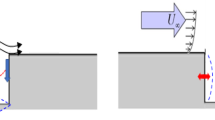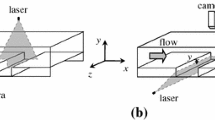Abstract
Turbulent subsonic “transitional–open” cavity flow was investigated by wind-tunnel tests. The investigated cavity configuration had a length-to-depth ratio of 6.25 and a width-to-depth ratio of 2. The cavity was exposed to a free-stream Mach number of 0.40 and a Reynolds number (based on cavity depth) of \(1.6\times 10^6\), with a turbulent incoming boundary layer. Measurements of velocity and wall pressures were taken simultaneously, which enabled the analysis of velocity–pressure cross-correlations. Special attention is paid to the shear layer that develops over the cavity and an emphasis is placed on the analysis of its characteristics and its stability. Application of linear hydrodynamic stability theory, together with examining velocity–pressure cross correlations, revealed that the behavior of the cavity shear layer is analogous to a free shear layer, approximately up to mid-length of the cavity, where further downstream nonlinear interactions occur.





















Similar content being viewed by others
References
Ahuja KK, Mendoza J (1995) Effects of cavity dimensions, boundary layer and temperature on cavity noise with emphasis on benchmark data to validate computational aeroacoustic codes. Cr–4653, NASA
Alvarez J, Kerschen E, Tumin A (2004) A theoretical model for cavity acoustic resonances in subsonic flow. In: 10th AIAA/CEAS aeroacoustics conference. AIAA Paper 2004-2845. American Institute of Aeronautics and Astronautics
Bendat JS, Piersol AG (2011) Random data: analysis and measurement procedures, vol 729. Wiley, London
Benjamin S, Roberts C (2002) Measuring flow velocity at elevated temperature with a hot wire anemometer calibrated in cold flow. Int J Heat Mass Transf 45(4):703–706
Brès GA, Colonius T (2008) Three-dimensional instabilities in compressible flow over open cavities. J Fluid Mech 599:309–339
Bruun HH (1995) Hot-wire anemometry: principles and signal analysis. Oxford University Press Inc., New York
Cattafesta L, Williams D, Rowley C, Alvi F (2003) Review of active control of flow-induced cavity resonance. AIAA Pap 3567:2003
Charwat AF, Roos JN, Dewey CF, Hiltz JA (1961) An investigation of separated flows, part II, flow in the cavity and heat transfer. J Aerosp Sci 28(6):457–470
Colonius T (2001) An overview of simulation, modeling, and active control of flow/acoustic resonance in open cavities. In: 10th AIAA/CEAS aeroacoustics conference. AIAA Paper 2001-0076. American Institute of Aeronautics and Astronautics
Hankey W, Shang J (1982) The numerical solution of pressure oscillations in an open cavity. Technical report, DTIC Document
Kannuluik W, Carman E (1951) The temperature dependence of the thermal conductivity of air. Aust J Chem 4(3):305–314
Kjelgaard SO (1988) Theoretical derivation and calibration technique of a hemispherical-tipped, five-hole probe. Tm–4047, NASA
Lin JC, Rockwell D (2001) Organized oscillations of initially turbulent flow past a cavity. AIAA J 39(6):1139–1151
Liu R, Ting DS, Rankin GW (2004) On the generation of turbulence with a perforated plate. Exp Therm Fluid Sci 28(4):307–316
Maull DJ, East LF (1963) Three-dimensional flow in cavities. J Fluid Mech Digit Arch 16(4):620–632
Michalke A (1965) On spatially growing disturbances in an inviscid shear layer. J Fluid Mech 23(3):521–544
Murray N, Sällström E, Ukeiley L (2009) Properties of subsonic open cavity flow fields. Phys Fluids 21(9):095103
Ritchie SA, Lawson NJ, Knowles K (2003) An experimental and numerical investigation of an open transonic cavity. In: 21st applied aerodynamics conference, pp 23–26
Rockwell D, Naudascher E (1979) Self-sustained oscillations of impinging free shear layers. Annu Rev Fluid Mech 11(1):67–94
Rokita T (2014) Experimental and numerical investigation of the subsonic flow field inside and near a Weapons Bay. Ph.D. thesis, Technion, Israel Institute of Technology
Rokita T, Arieli R, Levy Y (2012) Different approaches for simulating the flow inside and near a weapons-bay. In: 30th AIAA applied aerodynamics conference, 2012-3339
Rossiter JE (1964) Wind-tunnel experiments on the flow over rectangular cavities at subsonic and transonic speeds. T-r 64037, RAE
Rowley CW, Colonius T, Basu AJ (2002) On self-sustained oscillations in two-dimensional compressible flow over rectangular cavities. J Fluid Mech 455(1):315–346
Rowley CW, Williams DR (2006) Dynamics and control of high-reynolds-number flow over open cavities. Annu Rev Fluid Mech 38:251–276
Rowley CW, Williams DR, Colonius T, Murray RM, Macmynowski DG (2006) Linear models for control of cavity flow oscillations. J Fluid Mech 547:317–330
Sarohia V (1975) Experimental and analytical investigation of oscillations in flows over cavities. Ph.D. thesis, California Institute of Technology
Schlichting H (1968) Boundary-layer theory. McGraw-Hill, New York
Shaw L (1995) Weapons bay acoustic environment control. CEAS/AIAA 141:1995
Stallings RLJ, Plentovich EB, Tracy MB, Hemsch MJ (1995) Measurments of store forces and moments and cavity pressures for a generic store in and near a box cavity at subsonic and transonic speeds. Tm-4611, NASA
Sutherland W (1893) The viscosity of gases and molecular force. Lond Edinb Dublin Philos Mag J Sci 36(223):507–531
Tracy MB, Plentovich EB (1993) Characterisation of cavity flow fields using pressure data obtained in the langley 0.3-meter transonic cryogenic tunnel. Tm-4436, NASA
Tracy MB, Plentovich EB (1997) Cavity unsteady-pressure measurements at subsonic and transonic speeds. Tp-3669, NASA, Langley Research Center
Ukeiley L, Murray N (2005) Velocity and surface pressure measurements in an open cavity. Exp Fluids 38(5):656–671
Acknowledgments
We wish to acknowledge the help and support of IAI wind-tunnel crew in conducting the experiments.
Author information
Authors and Affiliations
Corresponding author
Rights and permissions
About this article
Cite this article
Rokita, T., Elimelech, Y., Arieli, R. et al. Experimental characterization of turbulent subsonic transitional–open cavity flow. Exp Fluids 57, 60 (2016). https://doi.org/10.1007/s00348-016-2145-5
Received:
Revised:
Accepted:
Published:
DOI: https://doi.org/10.1007/s00348-016-2145-5




